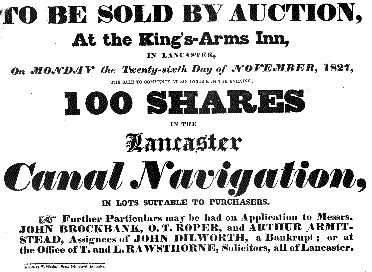![]()
In 1772 a group of influential Lancaster merchants came together with the idea of constructing a new canal from a junction with the Leeds and Liverpool Canal, near Wigan, northwards through Preston and Lancaster to terminate at Kendal.
Trade to the port of Lancaster had been suffering from the silting up of
the Lune estuary, and unfavourable competition from the upcoming
port of Liverpool had caused further problems. A canal access
from the south was seen as a way of overcoming them and providing
a much-needed boost for Lancastrian trade.
The merchants approached the canal builder, James Brindley (formerly
a mill-wright), whose reputation had been established by the
construction of the Bridgewater Canal between Worsley and
Manchester in 1761. Unfortunately, due to ill-health, he was
unable to undertake the survey and this was done by his pupil and
son-in-law, Robert Whitworth.
The merchants were not happy with Whitworth's proposals and asked for
a revision of his plans for the crossing of the River Lune at
Lancaster. Several other surveyors offered proposals, none of
which suited the merchants, and the mattered puttered on until
1791, when thirty of the traders and merchants from Lancaster
petitioned the Mayor for a public meeting to decide whether or
not a canal link to the Leeds and Liverpool Canal would be
pursued.
 Four days later, at the meeting, a resolution was passed to promote the new canal and to open a subscription list. In October 1791 the
engineer, John Rennie, was asked by the committee to survey a
line for the proposed canal, which he did, completing it by
January 1792. The plan was for a broad canal to start at West
Houghton, in Lancashire, and to proceed north to Kendal, in
Westmorland - a total length of 75.5 miles.
Four days later, at the meeting, a resolution was passed to promote the new canal and to open a subscription list. In October 1791 the
engineer, John Rennie, was asked by the committee to survey a
line for the proposed canal, which he did, completing it by
January 1792. The plan was for a broad canal to start at West
Houghton, in Lancashire, and to proceed north to Kendal, in
Westmorland - a total length of 75.5 miles.
The next step was to obtain an Act of Parliament authorising the new
navigation, which was promoted by two Lancaster bankers, John
Dilworth and Thomas Worswick; John Brockbank, a ship-builder; the
colliery-owning Earl of Balcarres, and Thomas Crewdson and John
Wakefield of Kendal.
The Act was passed in June 1792, and incorporated the Lancaster Canal
Company, which appointed Rennie as its Chief Engineer, at an
annual salary of £600.
Above right: An advertisement for Shares in the Lancaster Navigation, dated 1821.
Copyright: Canalcaholic 1999
Last revised: August 2004